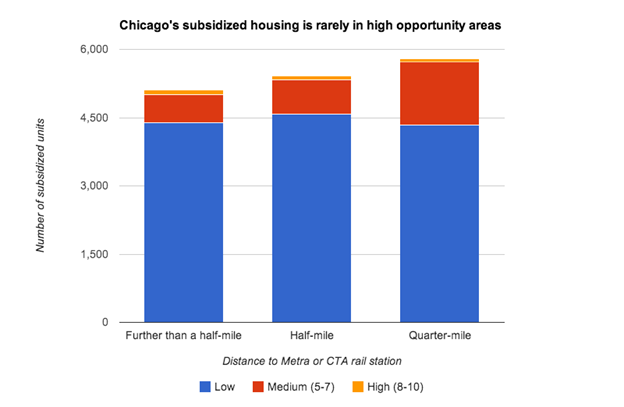
Flickr user Ian Freimuth (cc)
When the City of Chicago’s Dept. of Planning and Development released its Five-Year Housing Plan in early 2014, it was encouraging to see a commitment to exploring how to strengthen the Affordable Requirements Ordinance. However, the Ordinance doesn’t always fulfill its goals. In this series, the Metropolitan Planning Council (MPC) will explore a variety of ways to strengthen this ordinance and equip it to deliver results that Chicago’s residents desperately need.
In discussions about reforming Chicago’sAffordable Requirements Ordinance, a common proposal from developers is to allow for affordable units to be built in “linked developments” as a third alternative to on-site units or the fee-in-lieu. In other words, rather than build the affordable units in the development that triggered the requirement, the units could be built at a separate location, which for a variety of reasons may be preferable to the developer. While we fully support creative ideas that give developers a range of ways to deliver affordable units in profitable markets, this proposal requires safeguards.
Some developers have proposed allowing units in the same or contiguous neighborhood. Keep in mind that the goal of on-site units is to provide affordability in an otherwise market-rate development, thus providing opportunities for a wide range of residents to live in all parts of the city. Given Chicago’s highly segregated neighborhoods, the contiguous one may be worlds apart, demographically speaking,from the one in which the market-rate development is being constructed. For instance the Chicago Tribune reported that over the last month Humboldt Park experienced 80 reports of violent crime and 32.6 percent of residents lived in poverty, while neighborhood West Town experienced 39 violent crime reports and had 15.7 percent of its residents living in poverty. While providing quality, affordable housing anywhere is a positive step for rent-burdened Chicagoans, this proposal could easily miss the spirit of the goal to provide options in otherwise inaccessible neighborhoods.
To maintain the spirit of the requirement, the Metropolitan Planning Council proposes that linked developments be allowed provided that there is no more than a pre-determined variance in poverty rate between the two communities. We suggest that the poverty rate be within 5 percentage points of the census tract where the development is located.
Regarding the fee-in-lieu, it is important to note that the accumulated fees are used to help fill funding gaps for affordable housing throughout the city. As a former affordable housing developer whose projects came to fruition with the help of these fees, you will hear no argument from me that the fee-in-lieu should be eliminated. However, it is also the case that the fees generally wind up supporting great projects in impoverished areas on Chicago’s South and West sides. In other words, the city’s low-income neighborhoods continue to provide the vast majority of affordable units for the poor, while wealthier areas provide very little. In a city with runaway crime inequality, school closures primarily on the South and West sides and notorious segregation, the Affordable Requirements Ordinance has a critical role to play in ensuring that affordable units are not solely available in low-income communities.

Our research shows that other cities have enacted a series of safeguards for when and how the fee-in-lieu provision is allowed. In some cases, the fee-in-lieu is allowed only via City Council approval, or only when the required units would be less than 10. In other cases, cities have mandated that at least 50 percent of the units must be on site if the unit count is between 11 to 50, and if more than 50 units, all units must be built on-site. A tiered system is common both nationally and locally, including Arlington Heights, St. Charles and other cities across the Chicago region.
Another way to think about when to mandate on-site units goes back to the goal of providing access and lessening segregation. With that in mind, in the next installment we will explore what the Affordable Requirement Ordinance can learn from metrics established for “opportunity areas.”
Want to learn more? Take a look at the other posts in the series.